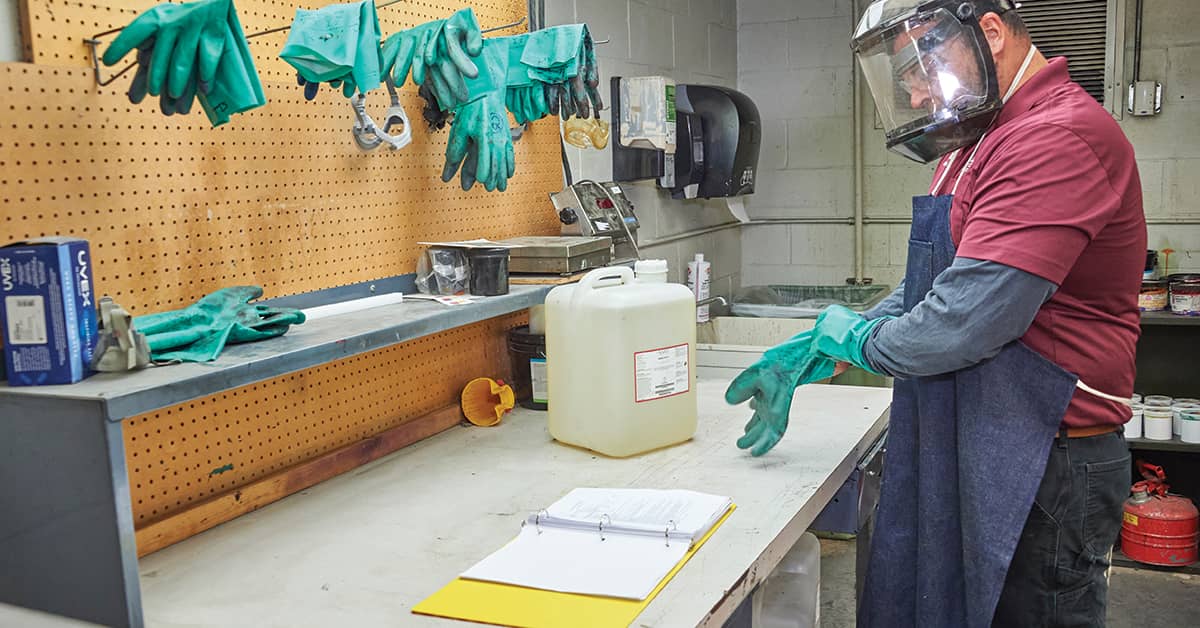Did you put that in writing? OSHA’s written HazCom program requirement
Date Posted: 05/19/2025

OSHA and its state partners cited the written program requirement under the Hazard Communication (HazCom) standard nearly 3,300 times last year! Typically, this means violators either didn’t have a written program or their programs didn’t include all the necessary information. Let’s take a closer look.
Who needs a written HazCom program?
If you’re covered by the HazCom standard at 29 CFR 1910.1200, in most cases, you must develop, implement, and maintain a written HazCom program. This standard kicks in if an employer has one or more employees exposed or potentially exposed to a “hazardous chemical” that is not otherwise exempted by the standard.
However, laboratories and operations where chemicals are only handled in sealed containers, such as a warehouse, do not need to have a written program. Yet, if you have these operations, you may have other responsibilities under the standard at paragraphs (b)(3) and (b)(4).
What are the written program requirements?
The written program requirements are listed in paragraph (e) of the standard. Essentially, the program is a record of how your organization will comply with the provisions of 1910.1200. It should provide enough detail to assess whether a good faith effort is being made to meet the requirements. Your written program must address:
- The chemical inventory/list,
- Labels and other forms of warning,
- Safety data sheets (SDSs),
- Employee information and training,
- Informing employees about the hazards of non-routine tasks,
- Informing employees about the hazards associated with chemicals in unlabeled pipes, and
- How you’ll exchange information in a multi-employer workplace.
This may sound overwhelming, so let’s break it down
Chemical inventory/list:
You must create a list of the non-exempt hazardous chemicals present in the workplace. The list must contain a product identifier for each chemical, and that identifier allows you and your employees to cross-reference it with an associated label and SDS. You may compile the list for the workplace as a whole or for individual work areas.
Labels and other forms of warning:
Include the name or title of the person responsible for ensuring proper labeling of any shipped containers of hazardous chemicals. Describe the labeling system used on in-house containers if it’s different than that on shipped containers.
SDSs:
Include the name or title of the person responsible for obtaining and maintaining SDSs. Explain where SDSs are located in your facility and how employees can access them. What’s the procedure if you don’t receive an SDS at the time of first shipment? What should employees do if they can’t find an SDS? If you use electronic SDSs, ensure you include details about how employees access backup SDSs when a primary access system is down.
Employee information and training:
Describe who you’re going to train – all employees or just those exposed (including potentially exposed) to hazardous chemicals. What topics will you cover? How often will you conduct training?
Hazards of non-routine tasks:
Your employees may occasionally perform tasks that will expose them to different chemical hazards than they’re used to. Examples might include confined space entry or tank cleaning. How will you handle these situations and ensure that employees involved have the necessary hazard information to stay protected?
Hazards associated with chemicals in unlabeled pipes:
Employees may perform work activities in areas where hazardous chemicals are transferred through unlabeled pipes. Prior to starting work in these areas, your employees must learn about the identity and hazards of the chemicals in the pipes, as well as required precautionary measures. Your program must explain how you’ll inform employees of these hazards and precautions.
Multi-employer workplaces:
If you have other employers onsite, your written program must describe how you’ll exchange information with them – such as the methods you’ll use to provide the other employers with SDS access, precautionary measures, and information about any labeling system used in your workplace.
Further details on what OSHA inspectors in the field will look for in a written HazCom program can be found in OSHA directive CPL 02-02-079.
How Safety Management Suite Can Help
Need a written hazard communication program? Want to revise or update an existing one? The Plans & Policies feature in J. J. Keller® Safety Management Suite® has a template to help! Use the filter to find our hazard communication program template.
E-mail Newsletter
Sign up to receive the weekly EHS Insider email newsletter for safety articles, news headlines, regulatory alerts, industry events, webcasts, and more.